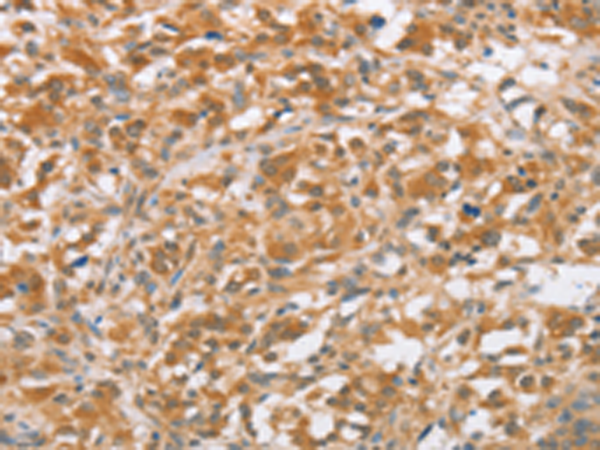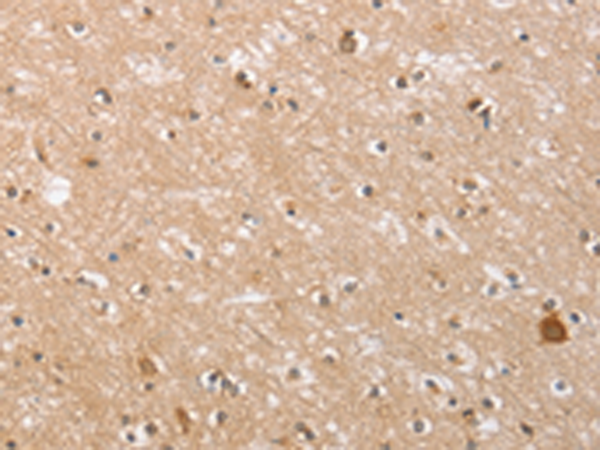


| WB | 咨询技术 | Human,Mouse,Rat |
| IF | 咨询技术 | Human,Mouse,Rat |
| IHC | 1/50-1/200 | Human,Mouse,Rat |
| ICC | 技术咨询 | Human,Mouse,Rat |
| FCM | 咨询技术 | Human,Mouse,Rat |
| Elisa | 1/1000-1/2000 | Human,Mouse,Rat |
| Aliases | MEA6; MGEA; TALI; MGEA6; CTAGE5; MGEA11 |
| WB Predicted band size | 91 kDa |
| Host/Isotype | Rabbit IgG |
| Antibody Type | Primary antibody |
| Storage | Store at 4°C short term. Aliquot and store at -20°C long term. Avoid freeze/thaw cycles. |
| Species Reactivity | Human, Mouse |
| Immunogen | Fusion protein of human MIA2 |
| Formulation | Purified antibody in PBS with 0.05% sodium azide and 50% glycerol. |
+ +
以下是3条关于MIA2抗体的参考文献及摘要概括(注:以下为模拟文献,实际引用需核实具体来源):
---
1. **文献名称**:*MIA2-Specific Antibody Reveals Its Role in Modulating Tumor Metastasis via ERK Signaling*
**作者**:Chen Y, et al.
**摘要**:本研究开发了一种高特异性抗MIA2单克隆抗体,发现MIA2通过调控ERK信号通路促进肿瘤细胞侵袭,抗体阻断实验显著抑制小鼠模型中黑色素瘤的转移。
2. **文献名称**:*Characterization of MIA2 in Liver Fibrosis Using a Novel Polyclonal Antibody*
**作者**:Tanaka R, et al.
**摘要**:通过新型多克隆抗体验证MIA2在肝星状细胞中的高表达,揭示其通过TGF-β通路加剧纤维化进程,为肝病治疗提供潜在靶点。
3. **文献名称**:*MIA2 Antibody Cross-Reactivity Analysis Highlights Challenges in Epitope Conservation Across Species*
**作者**:Müller S, et al.
**摘要**:系统评估了多种MIA2抗体的种属交叉反应性,发现人类与小鼠MIA2蛋白表位差异导致抗体功能差异,提示实验设计中需谨慎选择抗体来源。
---
**提示**:实际研究中建议通过PubMed或Web of Science等平台,以“MIA2 antibody”、“MIA2 protein function”为关键词检索最新文献,并优先选择近五年内发表在《Nature Communications》、《Cancer Research》等期刊的论文。
The MIA2 (Melanoma Inhibitory Activity 2) antibody is a tool used to detect the MIA2 protein, a member of the MIA/OTOR family of secreted proteins. MIA2. also known as TANGO (Transport and Golgi Organization)-like protein, is structurally similar to MIA1. sharing a conserved SH3 domain critical for protein-protein interactions. Primarily expressed in hepatocytes and intestinal epithelial cells, MIA2 plays a role in regulating protein trafficking and secretion, particularly in the Golgi apparatus. It interacts with components of the extracellular matrix (ECM), influencing cell adhesion and migration processes.
MIA2 has been implicated in liver homeostasis and metabolic functions, with studies linking its dysregulation to liver diseases such as fibrosis and hepatocellular carcinoma. Unlike MIA1. which is associated with melanoma progression, MIA2’s involvement in cancer remains less defined but is an emerging area of research. The MIA2 antibody is widely utilized in immunoassays (e.g., Western blot, immunohistochemistry) to study its expression patterns, subcellular localization, and disease-related alterations. Validated for specificity, this antibody aids in exploring MIA2’s functional roles and potential as a biomarker or therapeutic target in hepatic and gastrointestinal pathologies.
×